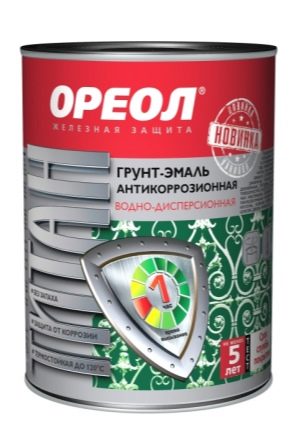Acrylic anticorrosive primer-enamel

The widespread use of acrylic paints and enamels is due to the fact that they allow painting a variety of surfaces, including metal. In this case, the anticorrosive properties of the paintwork are of particular importance. They are significantly better in acrylic primer-enamel for metal than in conventional paint. But only knowing exactly all the nuances of this mixture and the specifics of its use, you can achieve a positive result.


Peculiarities
Acrylic primer enamels are designed to paint a metal surface, including:
- vehicles;
- infrastructure facilities;
- Agreecultural machines. Agreecultural equipment;
- other items and objects for which solid decorative characteristics and a long service life are important.


Decent physical and chemical parameters, excellent aesthetic qualities, combined with a solid covering ability and ease of application, make such formulations one of the best.
After drying, the primer-enamel turns into a strong coating that is resistant to the negative effects of atmospheric processes. It retains its shine for a very long time, does not lend itself to impacts and various deformations.
Even with a short contact with water or industrial oils, anti-corrosion enamel fully justifies its name - the liquid will not be able to get to the metal.
There are many types of such enamels on the market, which differ in color.



Preparation for work
Ease of application does not mean that you can completely ignore the preparatory stage. The metal surface should be free of any stains, water-soluble deposits, traces of grease and oil. To get rid of these contaminants, use aromatic solvents (solvent, acetone, and so on), with which the rags are impregnated. It is important to check the substrate to ensure it is clean and dry. Cleaning can be done by hand, power tool, shot blasting or sandblasting.
The original coating is often strong enough and has no corrosion defects (with destruction of no more than 20% of the surface). Then only the deformed areas need to be processed. Otherwise, you need to clean the backing and fully cook the metal object.


Anticorrosive runt-enamel must be well mixed, and in some cases the solution must be diluted to the required viscosity.
Its meaning is as follows:
- when painting with brushes and rollers (60 seconds according to the viscometer);
- for aerosol spraying - from 25 to 30 seconds;
- when spraying in a vacuum - from 40 to 60 seconds.
Important: the diluted enamel must be mixed again and filtered through a steel sieve or mesh.


How to paint?
Primer-enamels are applied in one or two layers, when the temperature in the room is not less than +5 and not more than + 35 degrees, and the air humidity does not reach 80%. Each layer is made with a thickness of 30-40 microns. When two coats are applied, the coating should be applied at intervals of 15 minutes. At the same time, for each layer, from 0.1 kg per 1 square meter are consumed.This means that an ordinary container with a capacity of 25 kg should theoretically be enough for 250 m2.


The group "wagon" includes acrylic primer-enamel type AK-100helping the electrochemical protection of metals. Thanks to this, the surface is reliably covered from the action of destructive atmospheric processes, from contact with fresh and salt water. This type of primer enamel contains zinc and silver. If the paintwork is deformed, a galvanic combination of metals appears, which can reduce the corrosion rate by 10-40 times (compared to the corrosion rate of pure steel).
Two layers are almost always enough to protect the base for a decade and a half, and corrosion does not develop under the film.


The advantage of the AK-100 is also the absence of the need for auxiliary equipment, as well as savings in labor costs. Any kind of enamel can be applied on top.
For an overview of the Spetsnaz rust remover, see the video below.













The comment was sent successfully.